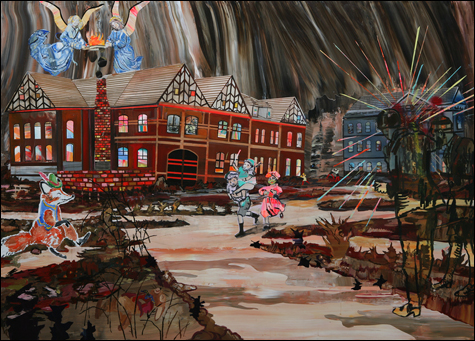
that is the national mood these days. |
“Strangefolks: John Copeland, Logan Grider, Elizabeth Huey”
Allston Skirt Gallery, 65 Thayer St, Boston, | Through February 16
“Langdon Graves: Preparations” and “Holly Coulis: Some People”
LAmontagne Gallery, 555 East 2nd St, South Boston | Through February 8
“Alexander DEmaria and Natasha Bowdoin: Myths and Fables”
Julie Chae Gallery, 450 Harrison Ave, Boston | Through January 26 |
An ill wind blows through Elizabeth Huey’s There’s a Boarded Bird Chirping Way Past Two (2008), part of a three-person exhibit of narrative paintings titled “Strangefolks” at the Allston Skirt Gallery (which is co-owned by Phoenix “Museums & Galleries” columnist Randi Hopkins). Three children lope down what appears to be a muddy path through a campus of institutional-type buildings. One child rides piggyback on another. The third kid, who seems to be wearing a muzzle mask, holds reins attached to one of the other’s pants. Behind them, the windows of a building are alight with ominous fluorescent energy, Renaissance-style angels collect smoke from a chimney into what might be a flaming crown, fluorescent rays explode out from another building, and little figures dash about in apparent terror. The black-brown sky seems to have melted, or maybe it’s the Northern Lights. A pair of transparent men watch the action from the foreground. And in the muddy rusty autumnal scrub at left, a fox, who could have been imagined by Richard Scarry, sits on a log and a smiling rabbit lies in brambles.As in a nightmare, the individual pieces have an evident order, and here and there they connect up to particular worries, but they never resolve into an overall message. Some have compared Huey’s mysterious narratives to those of “outsider” artist Henry Darger. Perhaps it’s illuminating to know that Huey, who lives in New York, has said that in her youth she spent time in a psychiatric institution, or that she used to worship as a Southern Baptist. Or maybe not. Either way, the portents look bad.
“Strangefolks” radiates an abject anxiety that is the national mood these days. We’ve had a pretty crappy millennium so far: September 11, wars in Afghanistan and Iraq (the latter hits its fifth anniversary in March), torture carried out in our name, a steady thumping of terrorist attacks abroad, Hurricane Katrina, global warming, and lately the mortgage crisis and threats of a looming economic recession. All this gloom and doom has burrowed down deep into our common dreams, mutated, and burbled back up in art as disconcerting symbols and off-kilter apocalyptic allegories.
Goth gloom is, of course, entertaining no matter the occasion, and at this particular juncture it feels apt and meaningful as well. But what makes “Strangefolks” an extra thrill is all the big, fresh, juicy painting going on here. Huey’s style is a charismatic variation of the popular Lucky Charms mode, which is recognizable by its glam fluorescent hues and patterns of hearts, stars, diamonds, and rainbows. And her scenes have an intriguing collaged-together look. That’s partly because she mixes hard-edged graphics with loose painterly passages, as well as flat and spatial modeling. But it’s mostly because she paints with stencils or masks out areas (or something like that), and this allows her to build up turbulent spots as thick and chunky as cake frosting but with edges so crisp that her designs appear pasted on.
The other “Strangefolks” painters are John Copeland of Brooklyn and Logan Grider of Kentucky. Copeland’s Your Eyes Are So Peaceful, But Your Hands Want More (2007) features two red, meaty blurry figures that seem to be wrestling on a snowy hillside under a blue-black night sky. It’s unclear what’s going on because of Copeland’s vigorous, loose, fluid style, but it looks bloody and violent, as if one figure had beaten the other to death. Random props — a fried egg on a plate, a Christmas tree on a stand, disembodied heads, a potted plant — fill out the scene. Busts of three figures hover in the air, like supernatural witnesses. Copeland’s other paintings remind me a bit of Gary Baseman (the illustrator behind Disney’s Teacher’s Pet) with ranks of cartoony devil heads and skulls (some with wings) threatening one another with tanks and cannons (or maybe they’re dicks and balls).
Grider has described his theme as a looming collapse of technology. Media Coverage (2007) depicts a teetering pile of televisions, power strips, wires, bowling balls (I think), pointy sticks (or maybe they’re rockets or chair backs), and a post with what appear to be hand grenades on top. Futurehuman (2007) shows a head sealed in a mask built from a tangle of wires, pipes, nails, and patches. It looks like some sort of techno bondage gear. Grider’s compositions and stylizations recall the work of the great young painter Dana Schutz, though his paint is a bit drier, thinner, more scraped down. Schutz’s work is a good place to find inspiration, but it would be nice to see Grider discover more of his own voice.